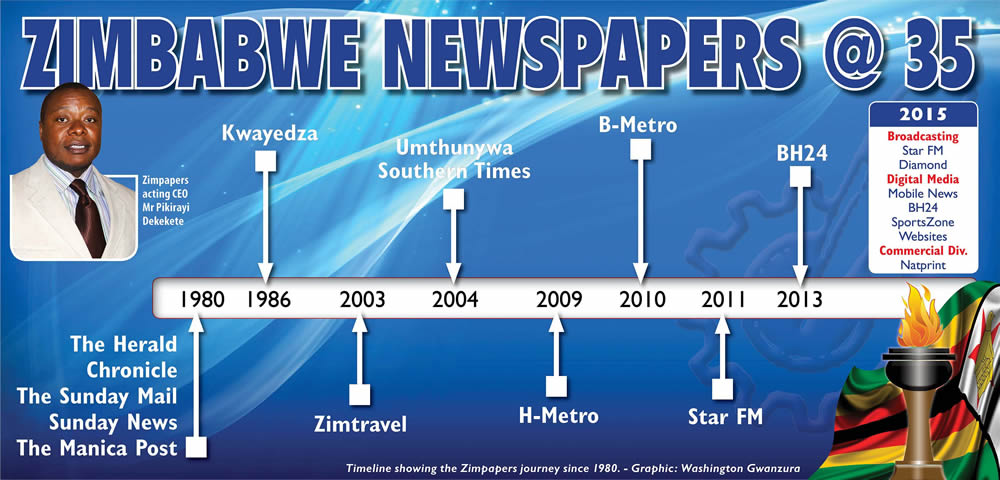Independence Supplement – The Zimpapers Journey: 1980 to 2015

 Herald Reporters
Herald Reporters
THE hashtag #1980sofarsogood aptly demonstrates the journey Zimbabwe Newspapers (1980) Ltd has travelled as a media company over the past 35 years, growing from strength to strength as the country’s biggest and most preferred generator and distributor of content in Zimbabwe.
The media group was born at independence in 1980 through the acquisition of a controlling shareholding in the then Argus Group by the ruling Zanu-PF Government using the newly created Mass Media Trust with the intention of ensuring that the story of the African people is correctly captured and told.
Contrary to many perceptions that Zimbabwean taxpayers’ money was used to acquire the media company, the truth of the matter is that the Nigerian Government was the one that provided the new independent Zanu-PF Government a grant to buy a controlling shareholding in the Argus Group before renaming it Zimbabwe Newspapers (1980) Limited.
The growth of Zimbabwe Newspapers (1980) Limited, the country’s largest media group, reflects in many ways the changes in Zimbabwe itself since independence.
Radical transformations in the early 1980s transformed a media company established and effectively controlled by South Africans into an indigenous company that was then able to build upon what it had inherited and develop further in new directions to serve people of Zimbabwe.
Zimpapers dates its origins to 1891 when the Argus Company in South Africa sent William Fairbridge north as its agent. He established the first newspaper in what is now Zimbabwe, using a makeshift cyclostyle “press” in a hut in what is now Africa Unity Square.
Over the 90 years of colonial history Argus maintained the dominance their leader had established and they built a commercially viable business. This was centred on two daily newspapers in Harare and Bulawayo, The Herald and The Chronicle, both set up in the early 1890s. In the 1930s Sunday papers, the Sunday News and The Sunday Mail, were added in the two cities, both converted from existing weeklies bankrupted by the Great Depression and bought cheaply by Argus, and a provincial paper, The Manica Post, in Mutare which was sold and bought back by Argus. A foray into Zambia during the Federal era ended after Zambian independence and two attempts to establish other dailies in Harare, the Evening Standard and The National Observer, were eventually abandoned.
The Argus connection, and especially the ability of that South African company to move second-hand presses and other technical equipment from South Africa as newspapers there outgrew presses that were still mechanically sound, helped the Zimbabwean subsidiary grow faster than it would otherwise have been able to do.
In 1927 the Zimbabwean operations became a true subsidiary with the establishment of the Rhodesian Printing and Publishing Company, but Argus even when it gave up its majority shareholding still retained an effective controlling shareholding.
The RP&P stable while dominating Zimbabwean media was limited in building a truly Zimbabwean media. Almost all staff came from South Africa in the early years and imports of immigrants from Britain filled a lot of vacancies from the 1930s right up to the 1960s.
Training and employment of Zimbabwean-born whites started filling senior posts from the 1960s but it was not until the 1970s that RP&P saw its first Zimbabwean-born editors and shortly afterwards its first Zimbabwean-born managing director.
The same decade saw a long-delayed employment of black apprentices for skilled technical posts and black journalism cadets.
In 1980 the new Zanu-PF Government found the major media company effectively foreign-controlled, and much of the staff culturally assimilated into that foreign company. While recognising that the newspapers were quite prepared to continue their policy of being generally supportive of the Government of the day, which was now the first majority-rule Government, there were concerns about how effectively the newspapers would be able to serve the new country.
A gift from Nigeria allowed the Government to set up the Mass Media Trust and buy out the South African interests, heralding the birth of Zimbabwe Newspapers (1980) Ltd and also ensuring that this was 100 percent Zimbabwean owned. Although the trust continued buying other small parcels of shares it limited its holding to 51 percent, enough to control the company without excluding other Zimbabweans.
The changes following the change in controlling ownership were important but quite small. New editors were appointed to the three major titles: The Herald, The Chronicle and The Sunday Mail. A new board of directors was appointed.
The company, with new direction, was then told develop as a Zimbabwean company. Simply changing editors ensured that the controlling vision of each newspaper was now managed by a Zimbabwean with Zimbabwean eyes and goals.
Changes occurred faster than planned. Argus guaranteed posts in South Africa for staff. An exodus of white staff created shortages but also opportunities. A fair number of exiled Zimbabwean journalists and printers returned home, Zambia providing the largest contingent, and were joined by survivors from the old African Daily News and freelancers who now came into their own.
Massive training schemes and larger intakes of apprentices soon filled the gaps. A small group of South Africans, opponents of apartheid, came north to fill odd gaps.
Editorially there were significant changes in what was covered and how it was covered, but with a strong emphasis on maintaining professional standards.
By 1984 Zimpapers was able to borrow long-term funds and buy its first-ever brand new printing presses, a pair of first generation colour litho presses from Goss for Harare and Bulawayo. Phototypesetting followed in the late 1980s. These changes allowed colour printing and maintained the commercial viability of the company.
Much of the work of the 1980s and 1990s was consolidating what was there when the changes took place and building up new markets and new readerships.
Two new titles, Kwayedza and uMthunywa were launched, providing weekly newspapers in national languages. To capitalise on regional synergies that were being created under the Sadc region, Zimpapers launched The Southern Times as a joint venture with Namibia’s New Era. The paper is sold in Zimbabwe, Namibia, South Africa, Botswana, Angola and Zambia.
At the end of the 1990s Zimpapers moved technically into the next century by commissioning its first digital production systems for editorial and advertising, allowing it to cut pre-production costs and become a lot more flexible.
The days of hyperinflation were days when survival was put first, and Zimpapers managed that feat without lowering standards. As the economy stabilised and started growing again a lot of thought was put into how the company should move forwards into the modern digital ages.
Websites were established in the early 2000s, a fairly easy undertaking since all material had been digital from the beginning of the century, but these were simply additions, rather than new markets, done because “everyone” was putting in websites rather than because of a business plan.
Serious business planning then saw bigger changes. The first was examining how Zimpapers could continue dominating its markets with the advent of greater competition and lower entry costs. Rather than move The Herald downmarket to compete with middle-market subsidised competition Zimpapers chose to segment the market, straddling it with the upmarket Herald and the tabloid H-Metro from 2009. The strategy was successful with The Herald remaining number one daily according to independent surveys and H-Metro generally racing neck-to-neck with the main two competitors.
Following the opening up of the airwaves by the ruling Zanu-PF Government to allow private players to own and operate their own radio and television stations, Zimpapers’ media strategy changed to embrace the new opportunities that were opening up in the broadcast media sector by becoming an integrated media company.
Zimpapers saw its opportunity of becoming more of a content company, less worried about platforms but using all available platforms for its specialised content. It thus applied for one of the first commercial radio licences, and in 2012 was able to launch Star-FM, whose small news staff are able to draw on the resources and content from the entire group.
Star FM is now the most popular national radio station in Zimbabwe and the biggest revenue earner in terms of advertising. The company has now moved further to consolidate its radio audiences by applying for a metro station in Mutare where it already enjoys a strong presence with the Manica Post newspaper.
The company’s application for Diamond FM was granted early this year and the station is scheduled to be fully operational by July this year, marking another first for the Zimpapers group.
Television is seen as the next step, although Zimpapers were one of the major start-up shareholders of the old RTV before the company was effectively nationalised in the UDI era.
This does not mean old systems are abandoned. In 2013 Zimpapers commissioned the most modern press in Zimbabwe, a four-tower full-colour third generation litho web press.
Digital publishing is likely to become the major platform within a few years as Zimbabwe continues following world trends. But this is simply seeing the continued transformation of Zimpapers from a newspaper company to a content company that seeks to use all available platforms to publish suitable packages of content. Although anyone can start a newspaper, or can open a website or can publish digitally, and these days can do so quite cheaply, what attracts readers and so attracts advertisers is the quality and quantity of the content.
A media company that has good content, whose content has been sifted for accuracy, and who has editors who can choose a selection of that content that will satisfy large groups of customers will be in a far more advantageous position than someone taking together bar talk and rumours.
With 124 years of finding content, 35 years of it within the new Zimbabwe, the time when whole generations of journalists have grown up, Zimpapers is confident it can continue to dominate its media markets as a content provider.










Comments